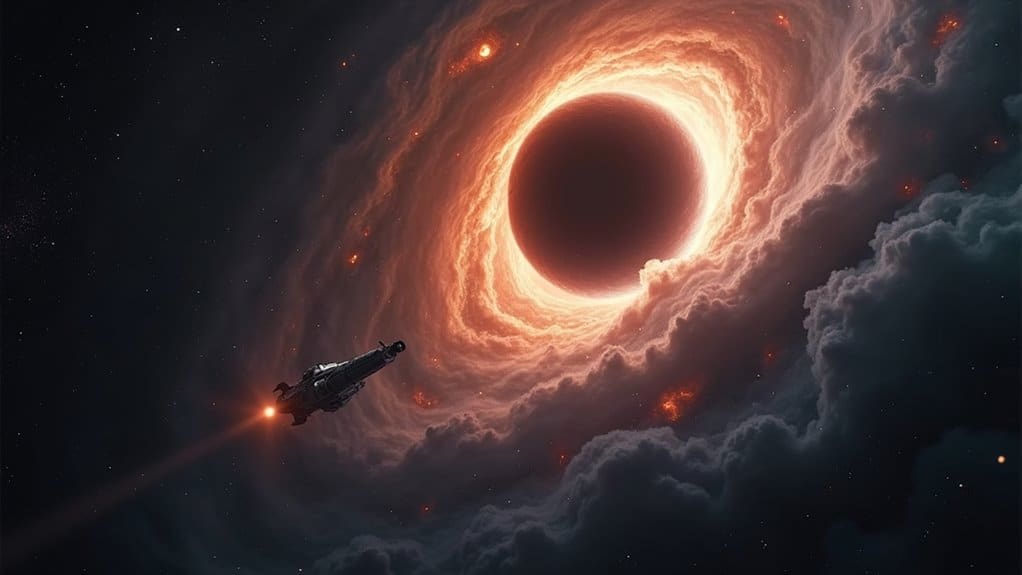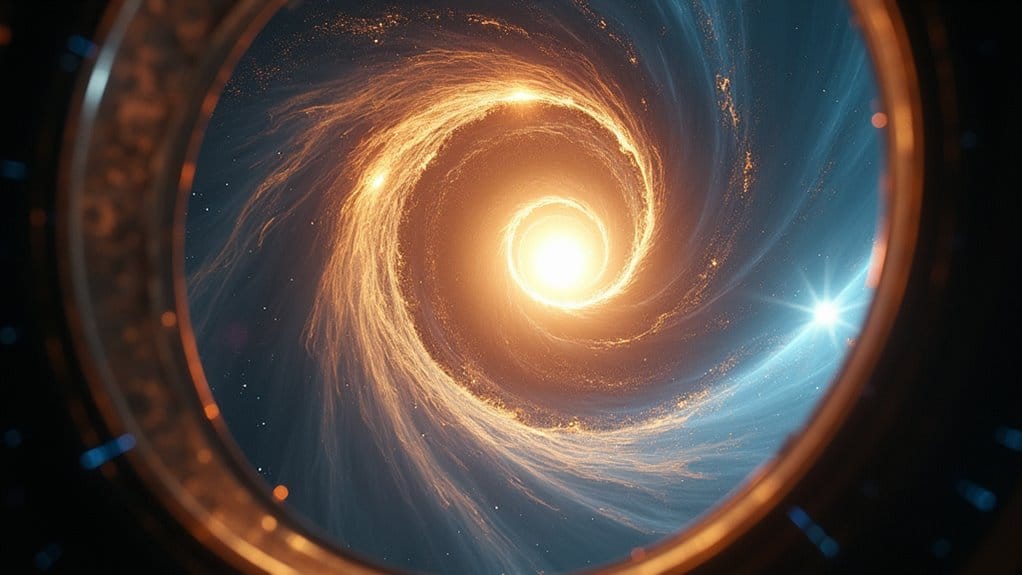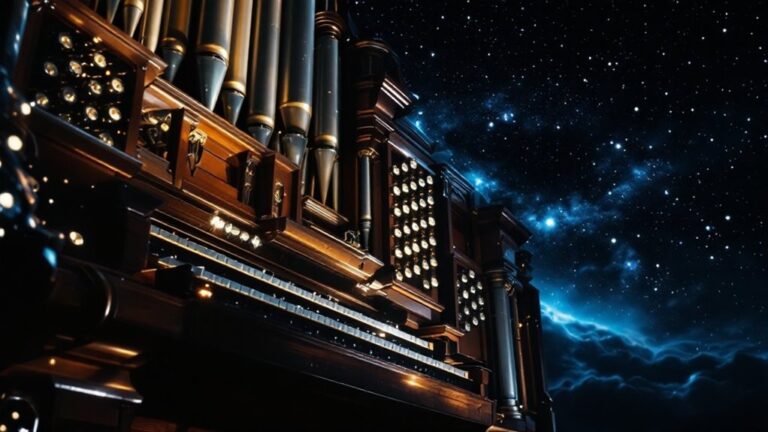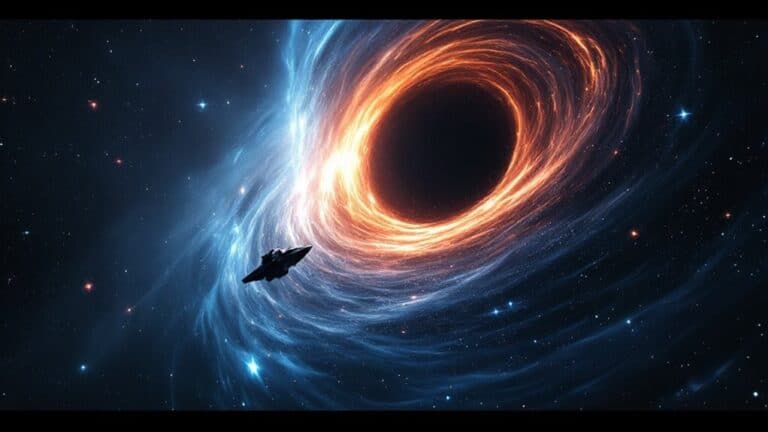Cinematic Techniques in Interstellar’s Direction
In “Interstellar,” Christopher Nolan employs groundbreaking cinematic techniques that merge scientific accuracy with emotional depth. You’ll notice the striking visual effects, particularly the realistic portrayal of black holes, achieved through the Double Negative Gravitational Renderer. Using IMAX cameras, Nolan captures both vast cosmic landscapes and intimate character moments, creating powerful connections with viewers. The dynamic camera work and handheld shots evoke emotional instability, enhancing the narrative’s gravity. Each component, from lighting to depth of field, deepens the cinematic experience, reflecting classic influences while innovating within the genre. Explore these elements further, and you’ll uncover even more intricacies at play.
Table of Contents
Key Takeaways
- IMAX cameras captured high-resolution cosmic landscapes, enhancing visual storytelling and audience immersion.
- Handheld shots on Earth reflected emotional instability, contrasting with steady IMAX shots in space that evoked wonder.
- Dynamic lighting techniques created a visual contrast between nostalgic warmth and the harshness of space, deepening emotional engagement.
- Close-ups of characters drew viewers into intimate moments, enhancing the film’s emotional resonance and connection.
- Collaboration with physicist Kip Thorne ensured scientifically accurate portrayals of complex concepts like black holes and gravitational time dilation.
Visual Effects Innovations
As you explore the visual effects innovations of *Interstellar*, you’ll discover how the creation of the DNGR (Double Negative Gravitational Renderer) code revolutionized the portrayal of black holes.
This groundbreaking technology eliminated the flickering effects typical of traditional methods, allowing for smooth and realistic visual effects. By tracing distorted paths of light beams instead of individual rays, the team achieved unprecedented accuracy. The DNGR code was instrumental in simulating gravitational lensing effects around black holes, further enhancing the film’s scientific credibility. Additionally, the visual representation of the black hole was based on known scientific principles, which added to its authenticity.
The DNGR code not only enhanced the film’s aesthetic but also provided valuable insights for astrophysicists, enabling simulations of gravitational lensing.
These technological advancements set a new standard in visual effects, bridging the gap between cinema and science. You can truly appreciate how art and technology converge to create a breathtaking representation of the mysteries of the universe.
Advanced Camera Techniques

In “Interstellar,” the use of IMAX cameras transforms the viewing experience, pulling you into the vastness of space like never before. You can’t overlook how the careful selection of lenses enhances this immersion, allowing each frame to capture not just detail but emotion. Horizontal shooting techniques further amplify the film’s grandeur, inviting you to appreciate the breathtaking scale of the universe alongside the characters’ personal journeys. The filmmakers also utilized scientific principles to guide the visual design, ensuring that the representation of phenomena like black holes and higher-dimensional spaces was both captivating and accurate. This commitment to innovative camera techniques not only enhances the visual narrative but also deepens the audience’s connection to the story’s themes.
IMAX Camera Utilization
IMAX cameras played an essential role in creating the visually stunning experience of *Interstellar*. Their advantages, such as high resolution and immersive image size, allowed for dynamic storytelling, despite the filming challenges they presented. The large format demanded careful composition to keep the viewer’s focus amid the expansive visuals. Each shot required precise technical assistance to manage the lengthy reload times and guarantee peak performance. The IMAX format utilizes 65mm film to create a larger image than standard formats, enhancing the overall visual impact of the film. This attention to detail in visual composition is evident throughout the film, where each shot is designed to be aesthetically pleasing and emotionally engaging.
| IMAX Camera Features | Practical Considerations |
|---|---|
| 65mm film format | Technical supervision needed |
| 24 frames per second | Longer reload times |
| 70.41mm × 52.63mm | Noise issues in quiet scenes |
| Handheld rigs used | Vacuum for flat film plane |
| Combination with other formats | Custom rigs for unique shots |
These elements combined to create a breathtaking cinematic journey.
Lens Selection Impact
The stunning visuals in *Interstellar* aren’t just a product of IMAX camera technology; lens selection plays a pivotal role in shaping the film’s immersive experience.
The use of specific lens characteristics, such as a short depth of field, sharpens focus on nearby objects while beautifully blurring the background, creating an extraordinary sense of three-dimensional space. This technique enhances the viewer’s connection to the spacecraft, allowing you to feel the tangible texture of elemental forces like wormholes. The choice of high-quality lenses, including Leica and Panavision, guarantees peak optical performance, seamlessly blending practical effects with CGI. The film’s sound mix, featuring formats like Dolby Surround 7.1, complements the visuals to create an unparalleled cinematic experience. Furthermore, the dynamic camera work enhances the emotional engagement of the audience, making them feel more invested in the characters’ journeys.
Horizontal Shooting Advantages
While exploring the vastness of space in *Interstellar*, you’ll quickly notice that horizontal shooting techniques greatly enhance your viewing experience. The use of large-format IMAX cameras captures high-resolution images, delivering stunning visuals that allow you to feel the true scale of the universe.
This horizontal shooting benefits immersive storytelling by presenting expansive cosmic landscapes alongside intimate character moments, creating a rich visual dialogue. You’ll appreciate the tactile quality film stock brings, adding authenticity to the sci-fi elements.
Additionally, the contrasting camera movements—steady in space and handheld on Earth—reflect the emotional landscape of the characters. By balancing grandeur and intimacy, *Interstellar* immerses you in its narrative, making you feel both the isolation of space and the warmth of human connection.
Cinematographic Style

Cinematographic style in “Interstellar” masterfully blends various techniques to immerse viewers in its profound narrative. The film employs handheld shots on Earth, reflecting the characters’ emotional instability, while steady IMAX shots in space evoke a sense of vastness and wonder.
This juxtaposition creates a rich tapestry of cinematic symbolism, enhancing the emotional resonance of the story. Close-ups draw you into intimate moments, while dynamic lighting choices amplify key scenes, contrasting nostalgic warmth with the harshness of space.
The alternating kinetic and steady shots reflect the emotional rhythm of the narrative, engaging you deeply. Each frame is carefully composed, balancing grandeur and intimacy, ultimately inviting you to explore humanity’s connection to the universe amidst isolation and vulnerability.
Commitment to Scientific Accuracy

In “Interstellar,” you see a remarkable blend of cinematic artistry and scientific precision, showcasing the filmmakers’ commitment to accuracy.
Collaborating with experts like physicist Kip Thorne, they bring complex concepts like gravitational time dilation and black hole physics to life, ensuring the cosmic depictions resonate with both realism and wonder.
This dedication not only enhances the film’s narrative but also invites you to reflect on the mysteries of the universe, making the experience both intellectually stimulating and emotionally profound.
Collaboration With Experts
To guarantee *Interstellar* maintained its scientific integrity, the filmmakers collaborated closely with experts like Kip Thorne, a renowned physicist.
Thorne’s expert contributions were essential in creating a narrative rooted in real-world science. His deep understanding of relativity guided the depiction of complex concepts, such as black holes and wormholes, ensuring their visualizations weren’t just imaginative but scientifically sound.
The film team engaged in rigorous scientific collaboration with Thorne and his research group, transforming abstract theories into stunning visuals that resonate emotionally.
This partnership not only enhanced the film’s authenticity but also inspired further scientific inquiry, showcasing how art and science can intertwine to deepen our understanding of the universe.
Such dedication elevates *Interstellar* beyond mere entertainment.
Accurate Cosmic Depictions
While many sci-fi films take creative liberties with cosmic phenomena, *Interstellar* stands out for its rigorous commitment to scientific accuracy.
The film’s black hole visualization, Gargantua, was meticulously crafted with insights from renowned physicist Kip Thorne, using equations from General Relativity. This resulted in stunning visuals that closely resemble real-life images captured by the Event Horizon Telescope.
Additionally, the wormhole representation, strategically placed near Saturn, aligns with theoretical physics as a plausible shortcut through space-time.
The film’s creators dedicated 100 hours of computational time per frame to guarantee these depictions weren’t only visually engaging but also scientifically faithful.
Quantum Physics Considerations
Building on its commitment to scientific accuracy, *Interstellar* also explores the complexities of quantum physics, particularly in relation to concepts like wormholes and gravitational fields.
The film investigates quantum coherence, suggesting that such phenomena could persist over vast distances in space, where the effects of atmospheric turbulence are minimal. This exploration highlights how information might traverse through gravitational fields, hinting at the potential for time manipulation.
Influences From Classic Cinema

Classic cinema profoundly shaped the visual and narrative landscape of “Interstellar,” drawing inspiration from iconic films that explored space and human emotion.
The cinematic legacy of classics like “2001: A Space Odyssey” and “Star Wars” informed Nolan’s direction, inspiring a commitment to realism and emotional depth. You can see these classic influences manifest in the film’s practical effects and grand storytelling, echoing the epic scope found in Spielberg’s works.
In addition, Nolan’s childhood fascination with space films breathes life into the narrative, blending nostalgia with innovation. By honoring these classic films, “Interstellar” not only pays homage to its predecessors but also elevates the genre, weaving together the threads of science fiction and profound human connection.
Notable Technical Achievements

The influence of classic cinema paved the way for groundbreaking technical achievements in “Interstellar.” This film stands out not just for its emotional storytelling but also for its revolutionary cinematography.
You’ll notice the technical mastery in its use of Panavision, which creates immersive visuals that resonate with scientific accuracy. The collaboration with physicists, particularly Kip Thorne, guaranteed that the portrayal of black holes and wormholes wasn’t just imaginative but grounded in real science.
The creation of the DNGR code allowed for groundbreaking visualization of cosmic phenomena, enhancing the film’s visual impact. With over 100 hours dedicated to rendering single frames, “Interstellar” sets a high standard, merging art with scientific inquiry, and leaving an indelible mark on both cinema and astrophysics.
Conclusion
In exploring the cinematic techniques of “Interstellar,” you see how Nolan transcended traditional filmmaking, blending scientific rigor with emotional depth. The film’s groundbreaking visual effects and advanced camera techniques create a breathtaking experience, akin to watching a cosmic ballet unfold. By intertwining influences from classic cinema, Nolan not only honors the past but also propels the genre forward. Ultimately, “Interstellar” stands as a tribute to how cinema can stretch the boundaries of imagination, much like the space-time continuum itself.







